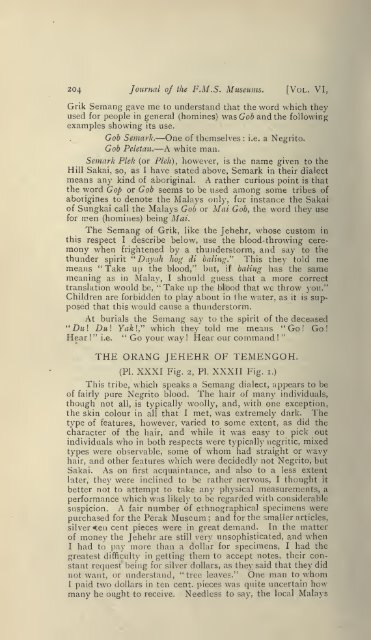Journal of the Federated Malay States museums - Sabrizain.org
Journal of the Federated Malay States museums - Sabrizain.org
Journal of the Federated Malay States museums - Sabrizain.org
Create successful ePaper yourself
Turn your PDF publications into a flip-book with our unique Google optimized e-Paper software.
204 <strong>Journal</strong> <strong>of</strong> <strong>the</strong> F.M.S. Museums. [Vol. VI,<br />
Grik Semang gave me to understand that <strong>the</strong> word which <strong>the</strong>y<br />
used for people in general (homines) was Go6 and <strong>the</strong> following<br />
examples showing its use.<br />
Gob Semark.—One <strong>of</strong> <strong>the</strong>mselves : i.e. a Negrito.<br />
Gob Peletau.—A white man.<br />
Semark Plek (or Pleh), however, is <strong>the</strong> name given to <strong>the</strong><br />
Hill Sakai, so, as I have stated above, Semark in <strong>the</strong>ir dialect<br />
means any kind <strong>of</strong> aboriginal. A ra<strong>the</strong>r curious point is that<br />
<strong>the</strong> word Gop or Gob seems to be used among some tribes <strong>of</strong><br />
aborigines to denote <strong>the</strong> <strong>Malay</strong>s only, for instance <strong>the</strong> Sakai<br />
<strong>of</strong> Sungkai call <strong>the</strong> <strong>Malay</strong>s Gob or Mai Gob, <strong>the</strong> word <strong>the</strong>y use<br />
for men (homines) being Mai.<br />
The Semang <strong>of</strong> Grik, like <strong>the</strong> Jehehr, whose custom in<br />
this respect I describe below, use <strong>the</strong> blood-throwing ceremony<br />
when frightened by a thunderstorm, and say to <strong>the</strong><br />
thunder spirit " Dayah hog di baling.'" This <strong>the</strong>y told me<br />
means " Take up <strong>the</strong> blood," but, if baling has <strong>the</strong> same<br />
meaning as in <strong>Malay</strong>, I should guess that a more correct<br />
translation would be, " Take up <strong>the</strong> blood that we throw you."<br />
Children are forbidden to play about in <strong>the</strong> water, as it is supposed<br />
that this would cause a thunderstorm.<br />
At burials <strong>the</strong> Semang say to <strong>the</strong> spirit <strong>of</strong> <strong>the</strong> deceased<br />
" Dh\ Du\ Yakl," which <strong>the</strong>y told me means "Go! Go!<br />
"<br />
Hear<br />
! Hear " i.e. " Go your way !<br />
our command !<br />
THE ORANG JEHEHR OF TEMENGOH.<br />
(PI. XXXI Fig. 2, PI. XXXII Fig. i.)<br />
This tribe, which speaks a Semang dialect, appears to be<br />
<strong>of</strong> fairly pure Negrito blood. The hair <strong>of</strong> many individuals,<br />
though not all, is typically woolly, and, with one exception,<br />
<strong>the</strong> skin colour in all that I met, was extremely dark. The<br />
type <strong>of</strong> features, however, varied to some extent, as did <strong>the</strong><br />
character <strong>of</strong> <strong>the</strong> hair, and while it was easy to pick out<br />
individuals who in both respects were typically negritic, mixed<br />
types were observable, some <strong>of</strong> whom had straight or wavy<br />
hair, and o<strong>the</strong>r features which were decidedly not Negrito, but<br />
Sakai. As on first acquaintance, and also to a less extent<br />
later, <strong>the</strong>y were inclined to be ra<strong>the</strong>r nervous, I thought it<br />
better not to attempt to take any physical measurements, a<br />
performance which was likely to be regarded with considerable<br />
suspicion. A fair number <strong>of</strong> ethnographical specimens were<br />
purchased for <strong>the</strong> Perak Museum; and for <strong>the</strong> smaller articles,<br />
silver «ten cent pieces were in great demand. In <strong>the</strong> matter<br />
<strong>of</strong> money <strong>the</strong> Jehehr are still very unsophisticated, and when<br />
I had to pay more than a dollar for specimens, I had <strong>the</strong><br />
greatest difficulty in getting <strong>the</strong>m to accept notes, <strong>the</strong>ir constant<br />
request being for silver dollars, as <strong>the</strong>y said that <strong>the</strong>y did<br />
not want, or understand, "tree leaves." One man to whom<br />
I paid two dollars in ten cent, pieces was quite uncertain how<br />
many he ought to receive. Needless to say, <strong>the</strong> local <strong>Malay</strong>s

















